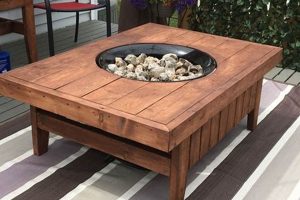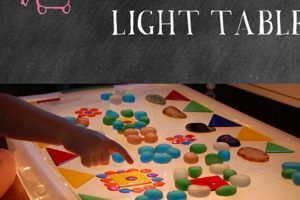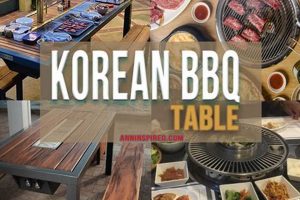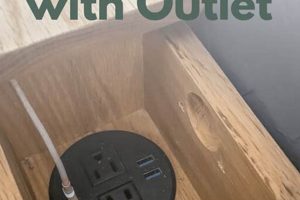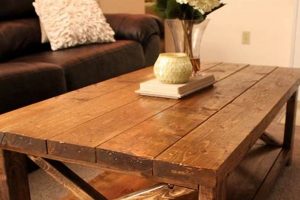Decorative items indicating table assignments, often homemade, are a common feature at events such as weddings, banquets, and conferences. These markers serve a practical purpose, guiding attendees to their designated seating areas. The creation of these items allows for customization and can contribute to the overall aesthetic of an event.
The utilization of handcrafted table identifiers offers several advantages. It presents a cost-effective alternative to commercially produced options, enabling event organizers to allocate resources to other aspects of the occasion. Furthermore, personalized creations can enhance the theme and ambiance, reflecting the unique style of the event. Historically, the concept of directing guests to specific seats has evolved from formal place settings to more casual, yet equally functional, arrangements.
The subsequent sections will explore various design ideas, material options, and construction techniques suitable for creating these bespoke table markers. These guides aim to provide clear instructions and inspiration for crafting practical and aesthetically pleasing solutions for event seating arrangements.
Guidance for Crafting Bespoke Table Identifiers
The following recommendations offer practical advice for the effective design and execution of unique table identifiers for formal events.
Tip 1: Material Selection: Prioritize durable and aesthetically complementary materials. Wood, metal, and acrylic provide structural integrity and visual appeal, ensuring longevity and coherence with the event’s overall theme.
Tip 2: Design Simplicity: Opt for uncluttered designs to maximize legibility. A clear, sans-serif font and adequate spacing between numerals enhance readability from a distance.
Tip 3: Structural Stability: Ensure the identifier’s base provides sufficient stability to prevent accidental toppling. A wider base or heavier material contributes to increased stability, particularly in outdoor settings.
Tip 4: Proportional Scaling: Maintain a scale appropriate to the table size and surrounding decor. An overly large marker can overwhelm the table setting, while an undersized one may prove difficult to locate.
Tip 5: Theme Integration: Align the identifier’s design with the overarching event theme. Incorporating relevant colors, patterns, or motifs reinforces the event’s aesthetic cohesion.
Tip 6: Cost-Effective Sourcing: Explore readily available and affordable materials. Repurposing existing items or sourcing materials in bulk can significantly reduce overall costs without compromising quality.
Tip 7: Testing and Refinement: Prototype the identifier design to assess its visual impact and structural integrity. Iterative testing allows for necessary adjustments and refinements before mass production.
Adhering to these guidelines will result in the creation of elegant, functional, and cost-effective table markers, enhancing the overall organization and aesthetic appeal of any event.
The subsequent section will address common challenges encountered during the crafting process and provide corresponding solutions.
1. Material Durability
Material durability constitutes a critical consideration in the creation of homemade table identifiers. The selected substance directly influences the longevity, resilience, and overall cost-effectiveness of these decorative and functional items.
- Resistance to Environmental Factors
The ability to withstand environmental stressors, such as moisture, sunlight, and temperature fluctuations, significantly impacts the lifespan of the identifier. Outdoor events necessitate materials resistant to weathering to prevent degradation, warping, or discoloration. For instance, using untreated wood in humid conditions will likely lead to premature decay, whereas a metal frame could oxidize if not properly sealed.
- Structural Integrity Under Stress
The material must maintain its structural integrity under various stress conditions, including accidental bumps, scrapes, or weight. The chosen material should be rigid enough to support the number display without bending or breaking. An example is the use of thin cardboard, which might easily collapse, as opposed to thicker acrylic or sturdy wood, which are more resistant to physical stress.
- Maintenance Requirements
Durable materials often require less frequent maintenance, saving time and resources. Materials that are easily cleaned and resistant to stains or scratches maintain their aesthetic appeal over time. Consider the use of materials like stainless steel or coated wood that can be easily wiped clean, compared to porous materials which might require more intensive cleaning or replacement.
- Long-Term Cost Implications
While initially more expensive, durable materials can provide better value over time by reducing the need for frequent replacements. The initial investment in a robust material such as metal or treated wood can offset the cost of replacing cheaper, less durable options that succumb to wear and tear more quickly.
The careful selection of durable materials for homemade table identifiers not only enhances their aesthetic appeal but also contributes to their functionality and long-term economic viability. Consideration of environmental factors, structural integrity, maintenance requirements, and long-term cost implications ensures the creation of table identifiers that withstand the demands of repeated use and diverse event settings.
2. Design Clarity
Design clarity is a critical component in the successful implementation of table identifiers, affecting their primary function: conveying table assignments efficiently. The efficacy of these markers hinges on their ability to be easily understood, a direct consequence of their design. A lack of design clarity undermines their purpose, causing confusion and disruption among attendees. Real-life examples of poorly designed identifiers include those with illegible fonts, obscured numbers, or designs that clash with the environment, leading to misdirected guests.
Achieving design clarity involves several factors. Font selection plays a pivotal role; simple, sans-serif fonts in a sufficient size are generally more legible than ornate or excessively stylized options. Contrast between the number and the background is crucial, ensuring the number stands out. Furthermore, the physical placement of the marker impacts visibility; it should be positioned at eye level and free from obstructions. Events held in dimly lit venues, for instance, necessitate identifiers with illuminated or reflective numerals to compensate for reduced visibility.
In summary, design clarity is not merely an aesthetic consideration but a functional imperative in creating effective table identifiers. Its absence negates the utility of the markers, while its presence streamlines the seating process and enhances the overall event experience. Challenges in achieving design clarity can be mitigated through careful font selection, color contrast consideration, and strategic placement, thereby reinforcing the broader theme of event organization and attendee satisfaction.
3. Structural Stability
Structural stability is a fundamental attribute of any table identifier, especially those created through do-it-yourself methods. It directly impacts the functionality, longevity, and safety of these decorative yet practical items. A lack of stability renders the identifier ineffective, potentially causing disruption and detracting from the event’s overall aesthetic.
- Base Design and Weight Distribution
The design and weight distribution of the identifier’s base are crucial for preventing accidental toppling. A wide base or the incorporation of heavier materials at the base lowers the center of gravity, increasing stability. Examples include using a solid wood block as a base versus a thin wire frame, or filling a hollow base with sand or pebbles to add weight. The choice directly influences the identifier’s ability to withstand accidental bumps or uneven table surfaces. An unstable base not only disrupts the event but also presents a potential hazard if the identifier falls onto guests or surrounding objects.
- Material Rigidity and Support
The rigidity of the materials used in the identifier’s construction contributes significantly to its overall structural integrity. Flexible materials, such as thin cardstock or flimsy wire, may bend or buckle under their own weight or slight external pressure, leading to instability. Conversely, using rigid materials like solid wood, metal, or thick acrylic ensures that the identifier maintains its shape and upright position. Reinforcements, such as internal supports or bracing, can further enhance stability, particularly for taller or more elaborate designs. Inadequately supported identifiers are prone to collapse, requiring constant readjustment and diminishing their visual appeal.
- Joint Integrity and Fastening Methods
The method of joining different components of the identifier plays a critical role in its structural soundness. Weak joints, whether due to inadequate adhesives, loose screws, or poorly executed welds, compromise the identifier’s overall stability. Secure fastening methods, such as robust adhesives, screws, bolts, or welding, ensure that the components remain firmly connected, preventing wobbling or separation. For instance, using a high-strength epoxy to join a wooden base to a metal number display creates a durable and stable connection, while relying solely on glue might result in a fragile and easily broken joint. The integrity of the joints directly impacts the identifier’s ability to withstand handling and environmental conditions.
- Resistance to External Forces
The identifier’s ability to withstand external forces, such as wind gusts in outdoor settings or accidental contact from guests, is essential for maintaining its stability. A well-designed identifier will incorporate features that minimize the impact of these forces, such as a low profile to reduce wind resistance or a protective barrier to prevent accidental contact. The choice of materials and the overall design should consider the potential for external forces to destabilize the identifier. For example, a tall, lightweight identifier is more susceptible to toppling in windy conditions than a shorter, heavier design. Resistance to external forces ensures that the identifier remains upright and visible throughout the event.
In conclusion, structural stability is not merely a desirable trait but a necessity for effective and safe homemade table identifiers. By carefully considering base design, material rigidity, joint integrity, and resistance to external forces, creators can ensure that their identifiers remain functional and visually appealing throughout the event, contributing to a seamless and enjoyable experience for all attendees.
4. Theme Integration
Theme integration, in the context of handcrafted table identifiers, refers to the seamless incorporation of the event’s overarching aesthetic into the design and execution of these functional markers. The absence of thematic alignment can result in visual discord, undermining the overall ambiance and potentially detracting from the intended experience. Conversely, successful theme integration elevates the table identifiers from mere directional aids to integral components of the event’s decorative scheme. Real-world examples include weddings where rustic-themed identifiers, crafted from reclaimed wood and adorned with wildflowers, complement the natural, outdoor setting, or corporate events where sleek, minimalist identifiers, constructed from brushed metal, reinforce the brand’s modern, professional image. The consequence of incongruent identifiers is a disjointed and less impactful event.
Practical applications of theme integration extend beyond mere aesthetic considerations. The choice of materials, colors, fonts, and even the method of construction can subtly communicate the event’s purpose and tone. A formal gala, for instance, might employ elegant identifiers featuring calligraphy and metallic accents, while a casual fundraising event could utilize whimsical identifiers crafted from recycled materials. Furthermore, theme integration provides an opportunity to personalize the event and create a more memorable experience for attendees. For example, a travel-themed event could incorporate miniature suitcases or globes as identifier bases, reflecting the event’s central motif. This detailed approach not only guides guests to their tables but also contributes to the immersive atmosphere.
In summary, theme integration represents a critical aspect of crafting effective and visually cohesive table identifiers. By carefully aligning the design of these markers with the event’s overall theme, organizers can enhance the aesthetic appeal, communicate the event’s purpose, and create a more memorable experience for attendees. The challenge lies in striking a balance between thematic relevance and functional clarity, ensuring that the identifiers are both visually appealing and easily understood. This integration reinforces the broader objective of a well-planned and executed event.
5. Cost Effectiveness
Cost effectiveness constitutes a primary driver in the consideration of do-it-yourself table identifiers. The potential for significant expenditure reduction, compared to commercially produced alternatives, positions homemade options as an appealing choice for budget-conscious event organizers.
- Material Sourcing and Acquisition
The selection of readily available and inexpensive materials is paramount to achieving cost effectiveness. Repurposing existing items, such as reclaimed wood or recycled glass, minimizes procurement expenses. Bulk purchasing of basic components, like cardstock or wire, from discount suppliers further reduces material costs. This strategic sourcing directly impacts the overall financial outlay for crafting table identifiers.
- Labor Cost Reduction
The do-it-yourself approach inherently eliminates external labor costs associated with professional design and production services. The event organizer or their associates undertake the crafting process, substituting paid labor with personal effort. This transfer of responsibility translates to substantial savings, especially for large-scale events requiring numerous table identifiers.
- Customization and Scalability
DIY table identifier projects offer the flexibility to tailor design and production volume to specific event needs. This scalability prevents overspending on unnecessary identifiers, a common pitfall with pre-packaged commercial options. Customized designs also allow for the efficient utilization of available resources, minimizing material waste and associated costs.
- Long-Term Value and Reusability
The durability and adaptability of handcrafted table identifiers can contribute to long-term cost effectiveness. Durable materials and robust construction enable repeated use at subsequent events, amortizing the initial investment over time. Furthermore, customizable designs allow for modification to suit different event themes, extending the identifier’s usable lifespan.
The interplay between material selection, labor allocation, customization, and reusability underscores the cost-effective nature of do-it-yourself table identifiers. By strategically managing these factors, event organizers can achieve substantial savings while maintaining, or even enhancing, the aesthetic appeal and functionality of their table arrangements.
Frequently Asked Questions
The following questions address common concerns and misconceptions regarding the design, construction, and implementation of bespoke table identifiers.
Question 1: What constitutes the most durable material for creating table identifiers intended for outdoor use?
Weather-resistant materials, such as treated wood, powder-coated metal, or marine-grade plastic, are recommended for outdoor applications. These substances withstand exposure to moisture, sunlight, and temperature fluctuations, ensuring longevity and preventing premature degradation.
Question 2: How can readability be maximized in dimly lit event spaces?
Illuminated or reflective numerals enhance readability in low-light conditions. Backlit displays, reflective vinyl lettering, or the strategic placement of spotlights can significantly improve visibility and prevent attendee confusion.
Question 3: What strategies can mitigate the risk of table identifier instability?
A wide base, a low center of gravity, and the use of heavier materials at the base of the identifier improve stability and reduce the likelihood of accidental toppling. Securely fastening the identifier to the table surface may provide additional stability.
Question 4: How is thematic consistency maintained across diverse event styles?
Align the identifier’s design elements materials, colors, fonts, and motifs with the event’s overarching theme. A rustic-themed event, for instance, might feature identifiers crafted from natural wood, while a modern event could incorporate sleek metal or acrylic designs.
Question 5: What techniques optimize cost-effectiveness in large-scale table identifier projects?
Bulk purchasing of raw materials, repurposing existing items, and simplifying the design reduce overall costs. The utilization of readily available tools and equipment further minimizes financial outlay.
Question 6: What are common challenges encountered during the crafting process, and how can they be addressed?
Common challenges include material shortages, design flaws, and production delays. Proactive planning, meticulous material sourcing, iterative prototyping, and realistic time estimations can mitigate these issues.
These questions provide insight into critical aspects of homemade table identifier design and construction. Addressing these points contributes to the creation of effective, visually appealing, and cost-effective solutions for event seating arrangements.
The subsequent section will offer a concise summary of the key principles discussed.
DIY Table Number Holders
This exploration has detailed critical facets of diy table number holders, emphasizing material durability, design clarity, structural stability, thematic integration, and cost-effectiveness. Thoughtful consideration of these elements is crucial to the successful execution of functional and aesthetically pleasing table identifiers.
The creation of effective table identifiers demands a balanced approach, prioritizing both practicality and visual harmony. Event organizers are encouraged to utilize the insights provided to craft bespoke solutions that enhance organization and elevate the overall event experience. Further innovation in materials and design will undoubtedly shape the future of these essential event components.


